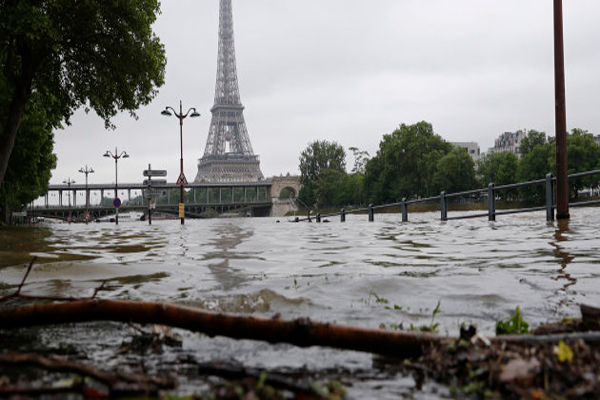A year on from the floods of June 2016, the French are still not safe from the risk of flooding.
The floods that struck from 30th May to 6th June 2016 may be the precursor to a larger flood, and we are not ready to deal with it.
 Pascal Klein
Pascal Klein
Founder of MegaSecurEurope, former officer of the Paris Fire Brigade

PHILIPPE WOJAZER / REUTERS
View of the Seine on 3rd June 2016.
While eastern Canada is grappling with its worst floods in half a century, plunging Montreal and 125 surrounding neighbourhoods into a state of emergency and prompting Prime Minister Justin Trudeau himself to claim that “the frequency of extreme weather events is accelerating, and [that] this is a consequence of climate change“, what is France’s track record a year on from the memorable floods that severely affected the tributaries of the Middle Seine and Loire rivers last June? Well, it’s not great.
Review of the June 2016 floods: a wake-up call
In a report published in February 2017 by the Ministry of Ecology and the Ministry of the Interior (1), we learned that our flood forecasting systems could be significantly improved, that too many municipalities do not have local protection plans, that limitations have been brought to light regarding the competence of the teams tasked with monitoring the embankments of the Loire and its tributaries, and that the financial aid systems for individuals set up by the State are most likely ineffective. Since this is an official report, these revelations are very troubling.
The floods that struck from 30th May to 6th June 2016 may be the precursor to a larger flood, and we are not at all prepared to deal with it when it comes.
National disaster insurance: A deceptive tax that undermines our risk culture!
France prides itself on having established a protective compensation scheme for natural disasters that demonstrates solidarity. However, this system underhandedly substitutes the comfort of receiving compensation for the effort of installing protection. After every flood, there’s a rush to declare an official state of natural disaster. (2)
However, of the 861 municipalities declared as being in a state of natural disaster in June 2016, more than half did not have a Flood Risk Prevention Plan or PPRI, the purpose of which is to regulate the use of land in zones liable to flooding. That is unforgivable!
The floods of June 2016, despite being moderate in scale, cost 1.2 billion euros, the second most expensive event since the creation of the natural disaster system (behind Storm Xynthia). It’s a sign of the times: the premiums paid out for natural disasters (see the natural disaster balance sheet for 1982-2015) are 3 times larger now than they were 30 years ago (1.6 billion euros in 2015).
This system will fall apart when the next major flood happens, and the only way the state will be able to compensate those who are insured will be by going into debt. It is inevitable.
For a century now, the country has avoided large-scale water level rises; the last major flood affected the Seine in 1910. However, it is estimated that the probability of a flood of this type occurring in the Paris region in any given year is 1/100. The financial cost of this event has been placed at 30 billion euros by the OECD.
When it comes to the Loire, the awful consequences of neglecting natural disasters could be even more terrible. Hundreds of thousands of citizens believe that they are protected by embankments built in the Middle Ages that have already given way many times, with the most recent major disaster taking place in 1856.
In the distant past, people were aware of the risks posed by nature. But today, excessive urbanisation, the dismantling of ecosystems, and the waterproofing of surfaces are all factors that exacerbate the consequences of exceptional weather events. Not to mention the lax approach of public policies with regard to building zones.
After gradually dyking up our rivers over the centuries and creating large structures to slow their flow, we have reached the limit when it comes to our exploitation of natural areas.
Are flood prevention action programmes effective? Nothing could be less certain…
Flood Prevention Action Programmes (PAPI) came into force in 2003 with the aim of lessening the consequences of floods through a global approach to risk, driven by a partnership between state services and local participants. The goal of these large-scale programmes: prevention by means of hundreds of increasingly complex flood studies and scenarios, allowing us to better understand the risks and protect our land, primarily through structural dynamic slowdown measures or hydraulic protection structures costing hundreds of millions of euros. (3)
When we read about the disasters of recent decades (Nîmes, Vaison-la-Romaine, Gard, Corsica, etc.), it seems reasonable to question the effectiveness of these investments and these often-inadequate protection systems.
Weather alerts, the Vigicrue flood risk system, scientific forecasts … we have never been so well-informed of impending natural disasters. However, when it comes to effectively protecting vulnerable residents and sites, there is (practically) nothing in place.
In an era of over-regulation, it seems that a “wait-and-see” attitude and a sense of inertia take precedence over action and protection. Yes, the climate is changing and we will have to prepare for it; no, the damage caused by flooding is not inevitable, because it is possible to protect ourselves if the state and local authorities care to equip themselves accordingly.
Today, we know that 1 in 4 French people and 1 in 3 jobs are potentially vulnerable to flooding. We must learn to live with this fact and try to mitigate the impact of this type of disaster.
How? By putting our most vulnerable activities out of reach of flooding, by protecting networks, by equipping ourselves with mobile emergency devices, and by developing wetlands, even in our cities themselves! Let’s stop covering our riverbanks in concrete and creating artificial reservoirs that cost enormous sums of money (estimated at tens of millions of euros) and whose efficacy is questionable. These passive protection systems do not protect citizens against torrential floods where they live.
Bearing in mind that it will take decades to correct the mistakes of the past, is this not the moment where we reach a turning point, making resilient adaptations and drawing up building regulations that truly take into account the risk of flooding?
As such, it is high time that public bodies stopped shifting the blame and clearly defined the remit and responsibilities of each stakeholder, not forgetting those of the civilian, the primary participant in civil society. Urgent action is required to establish tangible protective measures.
Does France guarantee the safety of all people and property? Let’s prove it.
(1) CGEDD report no. 010743-01 and IGA report no. 16080-R
(2) https://www.lesechos.fr/idees-debats/cercle/cercle-157774-les-couts-caches-du-regime-cat-nat-2004732.php
(3) http://www.georisques.gouv.fr/ma_maison_mes_risques/

